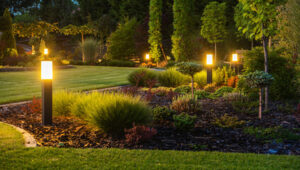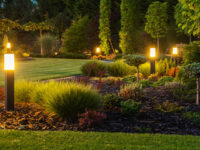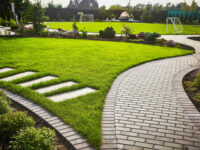Landscape Lighting Repair
A well-functioning landscape lighting system transforms outdoor spaces into a captivating ambiance. Regular upkeep is essential to maintain this mesmerizing illumination, however. humid climate accelerates wear on light fixtures and their wiring connections.
Before diving into landscape lighting troubleshooting, prioritize safety by ensuring the power is turned off and using insulated tools. Next, observe which lights flicker or don’t turn on at all. Contact Landscape Lighting Repair Orlando for professional help.
Using a few troubleshooting techniques and essential tools can help you tackle some landscape lighting repairs on your own. However, if the problem you are experiencing is beyond your ability to fix yourself, hiring a professional is the safest option. A pro can assess the problem and ensure that all the components are working properly.
One of the most common landscape lighting repair issues is a burned-out light bulb. A simple replacement of the bulb can restore the light to full functionality. A bad socket is another potential problem. Often, this can be diagnosed by examining the socket for signs of heat or smoke. If you notice this, it is likely that the socket has corroded.
Wiring problems are also common with landscape lighting systems. Exposure to the elements can cause corrosion and damage, which leads to poor connections or even a broken transformer. Inspecting the wiring regularly helps identify these problems before they become more serious.
A good way to test the voltage of your wires is to use a multi-tester or voltage meter. This tool can determine whether you have any faulty or unused wires, as well as check the overall health of your system.
Keeping your landscape lighting in optimal condition can enhance your property’s safety and beauty. Effective maintenance includes routine inspections and cleaning, regular bulb replacement, proper voltage management, and other steps to keep your landscape lights shining brightly. With the right care, your landscape lights can shine for years to come.
Inspection
Lighting systems are a valuable investment in beauty, safety, and security. Proper maintenance and timely repairs ensure a long-lasting, functional, and visually appealing landscape lighting system.
The key to maintaining the integrity of your lighting system is a thorough inspection. A landscape lighting professional will inspect your entire system to identify any problems. They will check everything from the sockets of your fixtures (where the bulbs plug in) to the underground wiring. They will look for any signs of damage or wear that can be addressed now to prevent future issues.
Electrical problems are a common concern in landscape lighting. Wires with improper gauge or connections can cause a range of issues, from flickering lights to power outages.
Low quality materials can also lead to severe problems in a short amount of time. Fixtures made of copper and brass hold up well to the elements and are worth investing in. Cheaper fixtures, however, can begin to corrode within a few years, resulting in expensive replacement costs.
Other things that may need repair are faulty bulbs and loose connections. Replace any burned-out bulbs promptly and make sure all connections are secure. Using the proper bulb size and type can prolong the life of your lighting system.
A landscape lighting professional will inspect all aspects of your fixture for damage, wear and tear, and electrical issues. They can even spot potential problems that might be hidden by overgrowth and vegetation. They will also be able to advise on the best options for your property and budget. Be sure to choose a licensed and insured contractor with experience and a positive reputation in the industry. They should also carry adequate insurance coverage to protect your home in case of an accident during the maintenance process.
Cleaning
Clean fixtures, check wires, and swap out old bulbs to extend the lifespan of your landscape lighting system. Proper care helps these systems showcase your property’s best features after dark, makes your outdoor spaces safer and more welcoming to guests, and minimizes energy waste.
In Florida’s humid climate, dirt and mineral deposits can build up on fixture bodies and lenses, resulting in dimming or even blocking of the light output. Regular cleaning and inspections help prevent these effects, especially when performed by a trained professional.
When your lighting contractors perform this maintenance, they can also ensure all wires are securely connected and in good condition. Faulty wiring – including frayed or broken wires – is a common safety hazard on any property and should be addressed right away.
Keeping tree branches, shrubs, and other vegetation trimmed also helps keep your lighting system safe and functioning properly. Landscape lighting fixtures are often placed in tight spaces surrounded by plant growth, which can cause them to get bumped or knocked out of alignment. It’s also common for maintenance crews or children to accidentally damage fixtures when mowing the lawn or playing soccer.
Performing a walkabout of your landscape lighting system during the daytime gives you the opportunity to inspect all your fixtures and see how their positions have changed over time. This is important because architectural lights positioned on walls are usually set in a precise spot that can’t be moved without dramatically changing their effect. However, landscaping lights in ground areas can be easily repositioned or trimmed to illuminate plants that have grown larger than expected.
Replacement
When a fixture is beyond repair, the best option is to replace it with a new one. This is a quick and simple DIY project that can restore the ambiance of your landscape lighting system. To make the process easier, learn about the basics of electrical wiring including how to shut off your power source and avoiding mistakes that can lead to electrocution. Additionally, learn about specialized tools such as wire toners and cable crimpers to advance your troubleshooting skills.
Start by walking around your outdoor space at dusk, noting any areas that are poorly lit or don’t turn on at all. From there, examine particular fixtures for signs of damage or a burned out bulb. Next, test each fixture for a proper connection by using a voltmeter to determine whether the bulbs are getting the right amount of power.
Once you’ve determined which light isn’t working properly, turn off the system and carefully remove the old bulb from its socket. Replace it with a new bulb, making sure that you’re selecting one of the same wattage to avoid overloading the system. Finally, clean the fixture to get rid of any accumulated dirt and grime that may be blocking the light’s effectiveness or causing other issues.
Keeping your landscape lighting in top condition can be an overwhelming task, but with a little knowledge and the right tools, it’s a manageable project for anyone. Whether you’re looking to illuminate your backyard paradise or simply add some curb appeal, the tips in this guide will help ensure that your lights shine brightly for years to come.
Enhancements
Landscape lighting can elevate curb appeal, highlight important areas of your property at night, deter intruders and even improve safety. A well-functioning system can also deter critters from nesting in trees or hiding in the dark and it helps prevent trips and falls on stairs and walkways. Consistent care for your outdoor lighting system ensures it shines brightly and accentuates the beauty of your garden, home, and architecture.
Regular assessments detect loose wiring or dead bulbs quickly and allow for timely repairs, extending the lifespan of your fixtures and optimizing their performance. Routine cleaning removes dirt, debris and mud from the exterior of your fixtures, preventing them from reflecting a dingy or unappetizing light. It also keeps the lenses free of scratches that can diminish the effectiveness of your landscape lighting design.
Adding a comprehensive inspection of all electrical connections to your maintenance plan is also essential for optimal landscape lighting repair. Using a multimeter, a professional can check continuity throughout the entire circuit to pinpoint any problem spots like frayed wires or loose connections. This allows them to take proactive measures to fix these problems before they escalate into more costly repairs or outright replacements.
Finally, it’s wise to implement a weatherproofing plan for your outdoor lighting system. This includes proper insulation for wires, sealing of electrical connectors to prevent moisture intrusion, and protecting the fixtures themselves from damage during seasonal storms or other extreme weather conditions.
It’s also important to keep tree branches and bushes properly trimmed so they don’t hang over or brush against your fixtures. This prevents them from accidentally getting hit by lawnmowers or being knocked out of alignment during routine maintenance.






